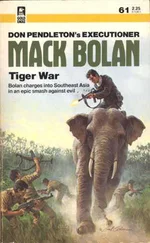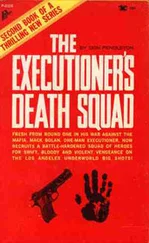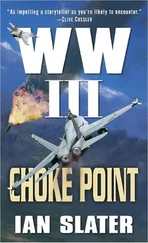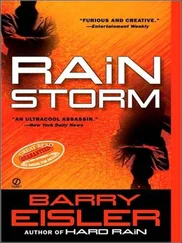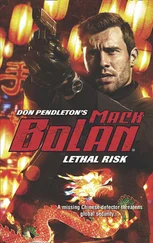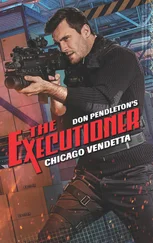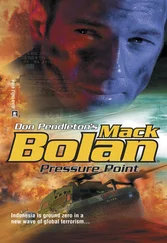That task complete, Brognola proceeded from his office to the electric tram in the basement. A hundred yards later, he stepped from the small transporter into the Operations Center of the Annex, a subterranean facility that housed the most modern electronic and human resources ever assembled for one purpose: combating America’s enemies. There were hundreds...nay, thousands of those who wished to do harm to the United States. Every single day of his life since agreeing to serve as top dog for the special-operations group code-named Stony Man, Brognola had worked tirelessly to protect the liberty and peace of his nation.
Stony Man did one thing and it did it very well, better than probably any other agency of its kind. But Brognola wasn’t so deluded to believe it was his consummate leadership skills that had held it together. Not even close. Stony Man worked for three reasons: brilliant and dedicated support staff, the finest and bravest collection of fighting men ever assembled and the ideals born from the devotion and loyalty of the man named Mack Bolan.
It was Bolan’s War Everlasting against the scourge of organized crime, and subsequently the forces of terrorism, that spurred the founding of Stony Man. It was Brognola’s relationship with Bolan—one that had started as a federal cop in pursuit of the fugitive nut-job calling himself the Executioner—that had led to his appointment as head of Stony Man. Today, Brognola was privileged to call Mack Bolan a lifelong friend. If Brognola had his way, he would have tracked Bolan down at that moment and sought his advice.
Brognola didn’t know exactly what the President’s intelligence people were sending, but he did have some inkling of where it was going. Maybe it was something that had to be handled by one of the teams, although he couldn’t imagine how the murder of one senator could spark a concern for international security. Still, Stony Man served at the pleasure of the Oval Office and whoever happened to occupy it, and Brognola could count on one hand the number of times the subject had been broached about whether it was necessary for their operations to continue. Every time, nixing the program had ultimately been shot down as a way to turn a very good idea into a potentially bad one. To Brognola’s knowledge, every President who’d entertained the idea had never come to regret the decision to keep Stony Man going: it was the final option.
“Is that coffee fresh?” Brognola asked Barbara Price as he entered the conference room.
“It is,” she said. “Would you like a cup?”
“Depends on who made it,” he replied. “I’m not sure I could handle any of Kurtzman’s rotgut right at the moment.”
Price raised one of her beautiful eyebrows. “You’re in luck, then. I made it.”
Brognola nodded in gratitude and then helped himself to a large cup. “You alerted Able Team?”
“I did,” Price said as she returned her attention to the built-in monitor in front of her, one of the many recessed into the massive conference-room table capable of seating a small army. In this case it was actually not an exaggeration. “I told them we’d be in touch as soon as we had some intelligence. And before you ask, Phoenix Force has been upgraded to standby.”
Brognola mumbled a thanks as he sat with his cup. He rubbed at his eyes and said, “The President’s intelligence reports from Justice should be coming through at any time. I don’t know the details yet, but obviously there’s much more to this than a dead politician.”
“Well, I thought I’d get a head start and had Bear pull Senator Maser’s dossier.”
“Items of interest, anything perhaps out of the ordinary?”
Price stared intently as she paged down the electronic file assembled by Stony Man’s resident computer expert and cyber-team leader, Aaron Kurtzman. “Unremarkable, to be honest. Maser was born and raised in New Hampshire. Entered his first term in office after working his way from a junior position in sales and marketing, and ending as CEO of the Biddler and Holmes Corporation.”
“What does that firm do?”
“What they did,” Price replied. “Past tense. They went under about three years after Maser left.”
“Maybe that’s our angle,” Brognola said. “It’s possible he left them high and dry, and when the company went belly-up somebody went looking for payback.”
Price shook her head. “That’s what I thought at first but it doesn’t fly. Maser left the company in the black, and actually it was extremely profitable. They went out of business due to poor investments and inadequate leadership, according to the financial statements and reports from independent audits conducted after Biddler and Holmes filed for bankruptcy.”
She handed one of the data sheets on that particular event to Brognola so he could see for himself. “Okay, so he’d been gone and running for public office long after that so it’s not likely anybody would have connected him to the company’s demise.”
Price nodded and then sat back in her chair and stretched. She continued, “His wife apparently comes from a wealthy family, and they’re the ones who originally backed his bid for a senate seat.”
“So you figure whatever happened here has something to do with the time frame after he entered public office.”
“I think it’s our best working theory, Hal.”
“What about that? Has there been anything extraordinary about his political career?”
“I’d say about average,” she said. “He hasn’t been particularly supportive of any key legislative issues, at least none that would be hot topics of debate, so it’s likely he didn’t draw the attention of any crazies. I—”
A loud ping echoed through the conference room and Price turned her attention to her display terminal. She mumbled something Brognola didn’t make out and then began tapping at the keys with the dexterity of an experienced typist, her unfashionably short fingernails producing clacking noises. When she’d finished typing, the display at the end of the conference room lit up to show a report stamped with “confidential” and bearing the seal of the U.S. Department of Homeland Security.
“It’s the reports from Justice that the President promised.”
Brognola squinted at the initial breakdown of the information contained within the file and then referred to a closer copy available on the terminal screen he raised out of the table. He perused the table of contents before finally pointing to one particular item: Associative Criminal Activities, Nonredacted.
“There,” Brognola said. “Pull up item fourteen, please.”
Price did and Brognola began to read in earnest. With every report of this kind, particularly if it contained sensitive or classified material, two official versions were typically circulated. To those outside the intelligence communities, there were redacted, abridged or even omitted pieces of data categorized by the Justice Department and National Security Agency with the remainder being labeled sensitive but classified, or just controlled unclassified information, which was typically reserved for official use only.
The material remaining was then considered either classified, secret or top secret and it was into one of these three categories that the kind of material Brognola now read typically fell. As the Stony Man chief absorbed the information he began to understand why such damning information wouldn’t be for dissemination to the public, or even to most individuals who didn’t possess a security clearance for it.
“Holy mother of—” Brognola began.
“My sentiments exactly,” Price interjected.
“Get Lyons on the phone. Immediately.”
* * *
WHEN CARL “Ironman” Lyons got the page from Stony Man to be on the alert, he was in the middle of climbing the Grand Tetons.
Читать дальше

